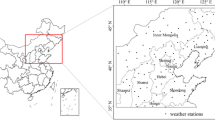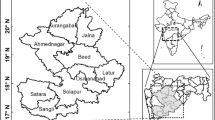Abstract
A new drought index, the agricultural dry condition index (ADCI), was developed to combine various hydrometeorological variables associated with agricultural droughts. It was calculated by applying weights to the soil moisture, vegetation activity, and land surface temperature data, which are used to monitor agricultural droughts. The vegetation health index (VHI) and microwave integrated drought index (MIDI) are also used to monitor agricultural droughts; these were calculated using satellite image data collected between 2001 and 2015 in South Korea and their spatiotemporal variations were analyzed. In order to compare the ADCI with actual agricultural drought conditions, land in South Korea was divided into two classes (rice paddies and croplands) and the ADCI values were compared to the corresponding crop yields (rice from rice paddies, potatoes and soybeans from croplands). There was no significant correlation between the ADCI and crop yield for the rice paddies because the water supply is controlled by irrigation. However, in the croplands there was a high degree of correlation with correlation coefficients of 0.83 and 0.80 for potatoes and soybeans, respectively. In order to confirm agreement with the actual affected areas, a receiver operating characteristic analysis was conducted for 2001 and 2015 when there was severe drought. This analysis found that the ADCI peaked at 0.68 in 2001 (June) 0.64 in 2015 (June). The ADCI was found to be highly applicable to the assessment of agricultural drought conditions. The VHI responded positively to land surface temperature while the MIDI responded to rainfall. However, the ADCI showed the best results because it is a weighted index of the input data, such as the land surface temperature, soil moisture, and vegetation activity, and their combination. The results confirmed that soil moisture, vegetation activity, and land surface temperature are the most important variables associated with droughts and that the ADCI can be effectively used to monitor agricultural droughts.
Similar content being viewed by others
References
Ahmadalipour, A., Moradkhani, H., Yan, H., and Zarekarizi, M. (2017). “Remote sensing of drought: Vegetation, soil moisture, and data assimilation.” Remote Sensing of Hydrological Extremes, Springer, Cham, Switzerland, pp. 121–149, DOI: https://doi.org/10.1007/978-3-319-43744-6_7.
Hao, Z., AghaKouchak, A., Nakhjiri, N., and Farahmand, A. (2014). “Global integrated drought monitoring and prediction system.” Scientific Data, Vol. 140001, pp. 1–10, DOI: https://doi.org/10.1038/sdata.2014.1.
Heim, Jr. R. R. (2002). “A review of twentieth-century drought indices used in the United States.” Bulletin of the American Meteorological Society, Vol. 83, No. 8, pp. 1149–1165, DOI: https://doi.org/10.1175/1520-0477-83.8.1149.
Keshavarz, M. R., Vazifedoust, M., and Alizadeh, A. (2014). “Drought monitoring using a soil wetness deficit index (SWDI) derived from MODIS satellite data.” Agricultural Water Management, Vol. 132, No. 31, pp. 37–45, DOI: https://doi.org/10.1016/j.agwat.2013.10.004.
Kim, J. S., Seo, G. S., Jang, H. W., and Lee, J. H. (2017). “Correlation analysis between Korean spring drought and large-scale teleconnection patterns for drought forecast.” KSCE Journal of Civil Engineering, Vol. 21, No. 1, pp. 458–466, DOI: https://doi.org/10.1007/s12205-016-0580-8.
Kogan, F. N. (1997). “Global drought watch from space.” Bulletin of the American Meteorological Society, Vol. 78, No. 4, pp. 621–636, DOI: https://doi.org/10.1175/1520-0477(1997)078<0621:GDWFS>2.0.CO;2.
Lee, D. R., Kim, W. T., and Lee, D. H. (2002). “Analysis of drought characteristics and process in 2001.” Proc. of Korea Water Resources Association Annual Conference, Korea Water Resources Association, Daejeon, Korea, pp. 898–903.
Lee, J. H., Park, S. Y., Kim, J. S., Sur, C., and Chen, J. (2018). “Extreme drought hotspot analysis for adaptation to a changing climate: Assessment of applicability to the five major river basins of the Korean Peninsula.” International Journal of Climatology, Vol. 38, No. 10, pp. 4025–4032, DOI: https://doi.org/10.1002/joc.5532.
Liu, X., Zhu, X., Pan, Y., Li, S., Liu, Y., and Ma, Y. (2016). “Agricultural drought monitoring: Progress, challenges, and prospects.” Journal of Geographical Sciences, Vol. 26, No. 6, pp. 750–767, DOI: https://doi.org/10.1007/s11442-016-1297-9.
MLIT (2002). 2001 drought impact investigation report, Ministry of Land, Infrastructure and Transport, Seoul, Korea, pp.32–60 (in Korean).
MLIT (2015). 2015 drought impact investigation report, Ministry of Land, Infrastructure and Transport, Seoul, Korea, pp.98–140 (in Korean).
Mishra, A. K. and Desai, V. R. (2005). “Drought forecasting using stochastic models.” Stochastic Environmental Research and Risk Assessment, Vol. 19, No. 5, pp. 326–339, DOI: https://doi.org/10.1007/s00477-005-0238-4.
Moorhead, J. E., Gowda, P. H., Singh, V. P., Porter, D. O., Marek, T. H., Howell, T. A., and Stewart, B. A. (2015). “Identifying and evaluating a suitalbe index for agricultural drought monitoring in the Texas High Plains.” Journal of the American Water Resources Association, Vol. 51, No. 3. pp. 807–820, DOI: https://doi.org/10.1111/jawr.12275.
Park, S. Y., Sur, C., Kim, J. S., and Lee, J. H. (2018). “Evaluation of multi-sensor satellite data for monitoring different drought impacts.” Stochastic Environmental Research and Risk Assessment, Vol. 32, No. 9, pp. 2551–2563, DOI: https://doi.org/10.1007/s00477-018-1537-x.
Rhee, J., Im, J., and Carbone, G. J. (2010). “Monitoring agricultural drought for arid and humid regions using multi-sensor remote sensingdata.” Remote Sensing of Environment, Vol. 114, No. 12, pp. 2875–2887, DOI: https://doi.org/10.1016/j.rse.2010.07.005.
Sánchez, N., González-Zamora, A., Martínez-Fernández, J., Piles, M., and Pablos, M. (2018). “Integrated remote sensing approach to global agricultural drought monitoring.” Agricultural and Forest Meteorology, Vol. 259, No. 15, pp. 141–153, DOI: https://doi.org/10.1016/j.agrformet.2018.04.022.
Sivakumar, M. V. K., Motha, R. P., Wilhite, D. A., and Qu, J. J. (2011). “Towards a compendium on national drought policy.” Proc. of an Expert Meeting on the Preparation of a Compendium on National Drought Policy, World Meteorological Organization, Washington DC, USA, pp. 1–135.
Sur, C., Jung, Y., and Choi, M. (2013). “Temporal stability and variability of field scale soil moisture on mountainous hillslopes in Northeast Asia.” Geoderma, Vol. 207–208, pp. 234–243, DOI: https://doi.org/10.1016/j.geoderma.2013.05.007.
Sur, C., Hur, J., Kim, K., Choi, W., and Choi, M. (2015). “An evaluation of satellite-based drought indices on a regional scale.” International Journal of Remote Sensing, Vol. 36, No. 22, pp. 5593–5612, DOI: https://doi.org/10.1080/01431161.2015.1101653.
Vaughan, D. A., Lu, B. R., and Tomooka, N. (2008). “The evolving story of rice evolution.” Plant Science, Vol. 174, No. 4, pp. 394–408, DOI: https://doi.org/10.1016/j.plantsci.2008.01.016.
Verstraeten, W. W., Veroustraete, F., van der Sande, C. J., Grootaers, I., and Feyen, J. (2006). “Soil moisture retrieval using thermal inertia, determined with visible and thermal spaceborne data, validated for European forests.” Remote Sensing of Environment, Vol. 101, No. 3, pp. 299–314, DOI: https://doi.org/10.1016/j.rse.2005.12.016.
Vicente-Serrano, S. M., Begueria, S., and Lopez-Moreno, J. I. (2010). “A multiscalar drought index sensitive to global warming: The standardized precipitation evapotranspiration index.” Journal ofClimate, Vol. 23, No. 7, pp. 1696–1718, DOI: https://doi.org/10.1175/2009JCLI2909.1.
Wilhite, D. A., Svoboda, M. D., and Hayes, M. J. (2007). “Understanding the complex impacts of drought: A key to enhancing drought mitigation and preparedness.” Water Resources Management, Vol. 21, No. 5, pp. 763–774, DOI: https://doi.org/10.1007/s11269-006-9076-5.
Woli, P., Jonesb, J. W., Ingramb, K. T., and Fraisseb, C. W. (2012). “Agricultural reference index for drought (ARID).” Agronomy Journal, Vol. 104, No. 2, pp. 287–300, DOI: https://doi.org/10.2134/agronj2011.0286.
Wu, Z., Mao, Y., Li, X., Lu, G., Lin, Q., and Xu, H. (2016). “Exploring spatiotemporal relationships among meteorological, agricultural, and hydrological droughts in Southwest China.” Stochastic Environmental Research and Risk Assessment, Vol. 30, No. 3, pp. 1033–1044, DOI: https://doi.org/10.1007/s00477-015-1080-y.
Zhang, A. and Jia, G. (2013). “Monitoring meteorological drought in semiarid regions using multi-sensor microwave remote sensing data.” Remote Sensing of Environment, Vol. 134, pp. 12–23, DOI: https://doi.org/10.1016/j.rse.2013.02.023.
Acknowledgements
This research was supported by Basic Science Research Program through the National Research Foundation of Korea (NRF) funded by the Ministry of Education (NRF-2017R1D1A1A02018546) and supported by Korea Environment Industry & Technology Institute (KEITI) though Water Management Research Program, funded by Korea Ministry of Environment (MOE) (79616).
Author information
Authors and Affiliations
Corresponding author
Rights and permissions
About this article
Cite this article
Sur, C., Park, SY., Kim, TW. et al. Remote Sensing-based Agricultural Drought Monitoring using Hydrometeorological Variables. KSCE J Civ Eng 23, 5244–5256 (2019). https://doi.org/10.1007/s12205-019-2242-0
Received:
Accepted:
Published:
Issue Date:
DOI: https://doi.org/10.1007/s12205-019-2242-0




